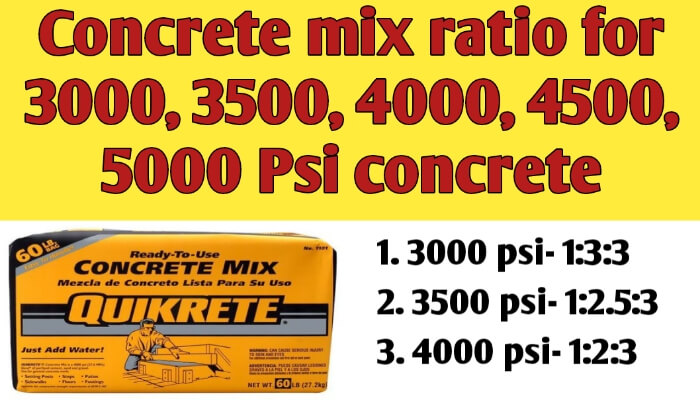The mix ratio for concrete varies based on the required strength, type of work and factors such as the quality of materials, mix consistency, and environmental conditions can also influence the final strength of the concrete. Typically, 1:3:3 (cement: sand: stone) is one of the best concrete mixing ratios for making a 3000 PSI mix. The mixing ratio is appropriate for a shed slab, the majority of footings, concrete patios, and foundation walls.

Concrete is blended mix of Portland cement, sand, gravel and water with approved additives. The concrete is typically used for various construction works like slab, fence post, sidewalk, footing & foundation, retaining walls, driveway, patio, floors slab, commercial floors, walkway, pool, bridge and etc.
Here are the typical mix ratios for various strengths:
- 2500 psi concrete mix ratio: 1:2:4 (cement: sand: stone), means 1 part cement mix to 2 parts sand, 4 parts gravel and 0.5 to 0.7 parts water.
- 3000 psi concrete mix ratio: 1:3:3 (cement: sand: stone), means 1 part cement mix to 3 parts sand, 3 parts gravel and 0.59 to 0.68 parts water.
- 3500 psi concrete mix ratio: 1:2.5:3 (cement: sand: stone), means 1 part cement mix to 2.5 parts sand, 3 parts gravel and 0.5 to 0.6 parts water.
- 4000 psi concrete mix ratio: 1:2:3 (cement: sand: stone), means 1 part cement mix to 2 parts sand, 3 parts gravel and 0.48 to 0.57 parts water.
- 4500 psi concrete mix ratio: 1:2:2.5 (cement: sand: stone), means 1 part cement mix to 2 parts sand, 2.5 parts gravel, and 0.4 to 0.5 parts water.
- 5000 psi concrete mix ratio: 1:2:2 (cement: sand: stone), means 1 part cement mix to 2 parts sand, 2 parts gravel, and 0.4 to 0.48 parts water.
In concrete terminology, the strength of concrete measured in Psi, which refers to the compressive strength of the concrete measured in pounds per square inch (psi). It indicates the maximum resistance the concrete can bear before it fails under compression. For example, 4000 psi concrete can withstand a pressure of 4000 pounds per square inch before it starts to crack or break under the applied load.
To create a concrete mix with the desired strength, cement, sand, aggregates and water are mixed in a fixed ratio. For example, to make 3000 psi concrete, you would mix 1 part cement, 3 parts sand, 3 parts gravel, and water (0.59 to 0.68 parts water per part cement).
For estimating purpose, to make one cubic yard of 4000 psi concrete, you need to mix 6 94lb bags of Portland cement, 12 cubic feet of sand, 18 cubic feet of gravel and 33 to 35 gallons of water, while to make one cubic yard of 3000 psi concrete, you need to mix 5 94lb bags of Portland cement, 15 cubic feet of sand, 15 cubic feet of gravel and 32 to 34 gallons of water.
In general, 5 bags of cement would be needed to make one cubic yard of 3,000 psi concrete, while 5.5 bags of cement would be required to make one cubic yard of 3,500 psi concrete.
Likewise, 6 bags of cement would be needed to make one cubic yard of 4,000 psi concrete, while 6.5 bags of cement would be required to make one cubic yard of 4,500 psi concrete.
In addition, 7 bags of cement would be needed to make one cubic yard of 5,000 psi concrete, while 8 bags of cement would be required to make one cubic yard of 6,000 psi concrete.
The mix ratio for 3000 psi (pounds per square inch) concrete typically consists of a mixture of cement, sand, and stone (aggregate/gravel). A common mix ratio for achieving 3000 psi strength is: 1:3:3 (cement:sand:aggregate) by volume, means 1 part cement 3 parts sand 3 parts aggregate.
To produce one cubic yard of 5,000 psi concrete, you need to mix 7 94lb bags of Portland cement, 14 cubic feet of sand, 14 cubic feet of gravel and 32 to 38 gallons of water.
To produce one cubic yard of 3,500 psi concrete, you need to mix 5.5 94lb bags of Portland cement, 13.75 cubic feet of sand, 16.5 cubic feet of gravel and 30 to 35 gallons of water.
To produce one cubic yard of 4,500 psi concrete, you need to mix 6.5 94lb bags of Portland cement, 13 cubic feet of sand, 13 cubic feet of gravel and 32 to 35 gallons of water.
Here’s are table for concrete mix ratio for 3000, 3500, 4000, 4500, 5000 Psi concrete:
| CONCRETE STRENGTH | CONCRETE MIX RATIO, (CEMENT : SAND : STONE) |
| 2500 PSI | 1 : 2 : 4 (cement:sand:stone) |
| 3000 PSI | 1 : 3 : 3 (cement:sand:stone) |
| 3500 PSI | 1 : 2.5 : 3 (cement:sand:stone) |
| 4000 PSI | 1 :2 : 3 (cement:sand:stone) |
| 4500 PSI | 1 : 2 : 2.5 (cement:sand:stone) |
| 5000 PSI | 1 : 2 : 2 (cement:sand:stone) |
Conclusions:
The concrete mix ratio for 3000 psi (pounds per square inch) concrete is: 1:3:3 (cement: sand: stone) by volume, means 1 part cement mix to 3 parts sand and 3 parts aggregate with 0.5 to 0.6 parts of water.